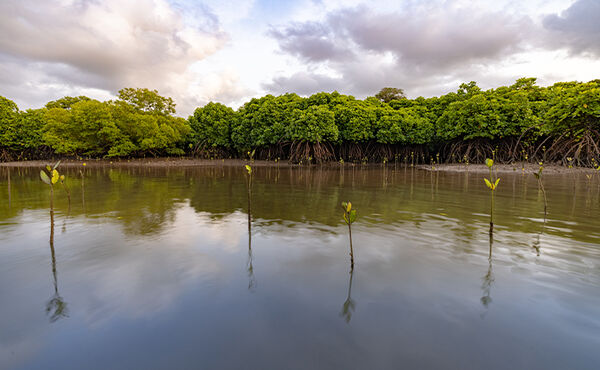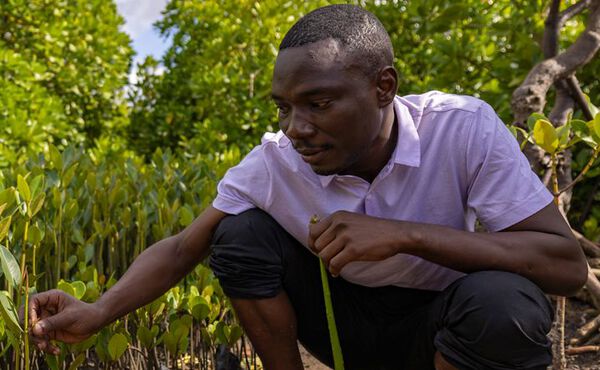We have been planting, protecting or restoring a tree for every refill sold. This is why, where and how.
On Earth Day 2021, we had a big announcement. We made a commitment to plant, protect or restore one tree for every refill sold throughout the year. During these three years, we have now committed to help grow over 9 million trees in total. To do this, we’ve worked with three incredible partners, supporting projects in India, Colombia and Kenya.
India
In partnership with EARTHDAY.ORG’s™ The Canopy Project, your refill purchase has helped to restore The Sundarbans, a UN World Heritage site and the largest deltaic region in the world. This area has sadly been a victim of climate change, resulting in the destruction of its mangrove forests. To help rehabilitate this area, the focus of this project was planting, protecting and restoring the mangrove trees that provide vital protection, and nutrient-rich habitats. Why is this so important? In 2022, we interviewed the project’s regional director, Karuna Singh, to paint a picture of the project and the impact it’s had, not only on the soil and forests but also on the local community.
Rituals: What is special about the Sundarbans and why was it chosen for this project?
Karuna: Reports state this site is one of the world's richest ecosystems but today, this rich natural wealth is threatened. It faces frequent floods and cyclonic storms, which have cleared space in the forests for wind to travel. Now, brackish water reaches further inland. Restoration of the mangrove ecosystems can contribute to community climate resilience and will help conserve biodiversity and help the absorption of greenhouse gas emissions. As the area is made up of mud flats, unless we help protect it now, lands will be lost.
Rituals: How important are mangroves to this area?
Karuna: The locals consider mangroves to be saviours. They act as bio-shields and the thicker the mangrove cover, the less winds can race through with disastrous intensity. Equally important, mangroves form natural dykes that repel tidal surges and strengthen vulnerable embankments from getting swept away. These provide safe havens for several coastal and marine species to flourish.
Rituals: How is this project helping the community?
Karuna: From the gathering of seeds and nurturing of nurseries to planting and protecting the mangroves, all of this will be done by the locals. This will provide a kickstart to economic betterment. With safer embankments and the possibility of reducing the effects of cyclones, the communities will be saved from spending to reconstruct after disasters. The locals involved will be trained in these skills and can carry on planting beyond the timeframe of this project. Tourism will also get a boost, earning more for the community.

Rituals: In 5-10 years, how much difference will this project have made?
Karuna: Mangroves sequester four times more carbon than other trees, so long-term, the 2 million mangroves we are planting, protecting or restoring will form a sustainable carbon sink. The Sundarbans are home to 4.5 million people and the surrounding city Kolkata is home to 30 million. This project will employ hundreds of individuals providing themselves and their families with an immediate economic stimulus. Over the next five+ years, the plantings from this project will significantly improve this area’s resilience to climate risks.
Rituals: What does a day look like in the life of the staff working on the project?
Karuna: Babu (our nursery head) and his colleague Mithun check the nursery. Babu has installed CCTV at the nursery which he checks first thing in the morning. He observes the tide from the live footage and then he makes a call on going to the nursery if the tide is low. He scrolls back through the footage to determine how much time has passed since the transition of the tide from high to low. This gives him an idea of how much time is available for work. He calls their colleague Yakub Kaka (kaka translates to an informal Mr. or Uncle) who then organises the work.
Mithun records the activities of the nursery such as the number of beds that have been completed and the number of propagules (germinated seeds) that have been planted. Babu and Mithun discuss with Animesh (our field accountant and seed acquisitions head) which seeds are required and in what quantities. Animesh, then arranges the seeds from various islands and goes about collecting the propagules with Mithun.
Manir (our manager) goes to the village heads and arranges for labourers to prepare the land for planting. The villagers are already aware of the countless benefits of mangroves, but with his master’s degree in Botany, Manir shares his knowledge of the species with them to reinforce this. Together with his colleague Siddharth, Manir maps the planting locations and discusses the areas that need land preparation and other protection measures that need to be undertaken.
Animesh collects all the data for field expenditures and other nursery requirements. Siddharth keeps track of all the progress with site inspections, surprise field visits, and constant communication with the other staff. He plans a weekly schedule with the help of his colleague Anilji and the lunar calendar. Once the schedule is set, they review all the pending activities and deadlines are set.
Kenya
In partnership with ClimatePartner, your refill purchase has helped to restore the mangrove forests in Tudor Creek, another area in vital need of conservation. Here are 5 reasons why this area was chosen.
1. It’s at risk of being submerged by rising sea levels
Tudor creek is a peri-urban ecosystem threatened by both climate change and the growth of Mombasa town. Home to 10 million people, Mombasa city is at risk of being submerged by water if the sea levels rise just 2%.
2. It was once home to a thriving mangrove forest
This area was once covered by 1641 hectares of mangroves and was home to many species of plants and animals. However, over time due to the El Niño rains of 1997 and continued anthropogenic activities (human-made pollution), the mangrove forests have depleted, and this has affected biodiversity.
3. The local area’s biodiversity benefits the mangroves
The mangrove ecosystem supports insects, crustaceans and fish populations, plus the growth of terrestrial trees, flora and fauna. With continuous restoration efforts, we slowly notice the increase in fish and crab stock.
4. Increased fish stock supports livelihoods
Besides limiting global warming effects, the increased fish stock creates sustainable livelihoods for the communities. The project also helps to educate locals on environmental conservation. Most importantly, the restoration efforts are mainly done by women who earn a living from nursery establishments and selling seedlings.
We are extremely proud of the work that has been done by our partners on these projects and hope to see these forests flourish in the years to come. This year, we will have an exciting announcement about a new project we will be supporting. Stay tuned to find out more!
Colombia
In 2022, we partnered with The Sacred Forest Foundation. Since then, your refill purchase has been helping the indigenous Arhuaco community of the Sierra Nevada, de Santa Marta Colombia to conserve their ancestral land. For centuries, the Arhuaco have protected these rainforests, but due to activities like logging and mining, large areas have now been deforested. That’s why we are sponsoring their efforts to buy back, reforest and protect their land for generations to come.
Stay tuned for more info on this project in the upcoming year!







.jpg?sw=600&sh=370&sm=fit&cx=340&cy=0&cw=722&ch=445&sfrm=jpg)


